In a nutshell, the Honda City Hybrid is the most efficient, cleanest and complex City yet. Its 26.5kpl ARAI-tested figure means it’s even more frugal than the City diesel (that does 24.1kpl) and its 89.5gm/km CO2 emission figure is best in class too. Making these numbers possible is the complicated powertrain that comprises electric motors, a lithium-ion battery, an Atkinson cycle engine and more. Oh, and it’s the first City with ADAS features too! Let’s go one by one.
Honda City Hybrid: design and styling
You’ll need to have a keen eye for detail to tell the City Hybrid apart from the standard models. Because badging aside (an e:HEV badge at the boot and Honda logos with a blue tinge), claw-like surrounds for the fog lamps, a boot lip spoiler and carbon-look diffuser are all that are unique to the Hybrid. Rear disc brakes are another distinguishing element exclusive to the Hybrid, but they’re hidden behind the familiar 16-inch alloy wheels.
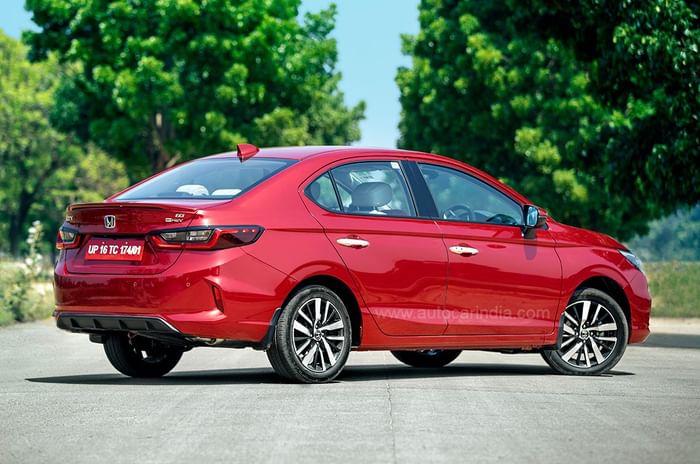
You can jazz up your City Hybrid’s look with official accessories but some more distinction would have been nice. Meatier rubber (it uses 185/55 R16 tyres) would also do much for the City’s stance. Worth mentioning is that the City Hybrid has the same 165mm ground clearance as the standard City, despite a 130kg increase in weight.
Honda City Hybrid: interior
It’s inside that there’s more to tell you that this is no ordinary City. For one, the 7.0-inch screen beside the speedometer no longer displays a tachometer. In its place, you get an informative energy flow meter that tells you where the power is coming from and how it’s going to the front wheels. You can also scroll through efficiency readouts, and it’s also where you’ll see the ADAS displays. Adaptive Cruise Control and Lane Keep Assist buttons are new additions on the steering, and the handbrake lever has been done away with altogether, making way for a button-operated electronic parking brake that’s exclusive to the Hybrid. At the back, you’ll find a vent in the right corner of the rear seat that’s there to channel cool cabin air to the battery behind. The good thing is that this vent is well incorporated and you can’t feel it when you’re seated there. And lastly, where the standard City features a beige on black interior colour theme, the City Hybrid uses an ivory on black combo. This lighter colour could be harder to keep clean though.
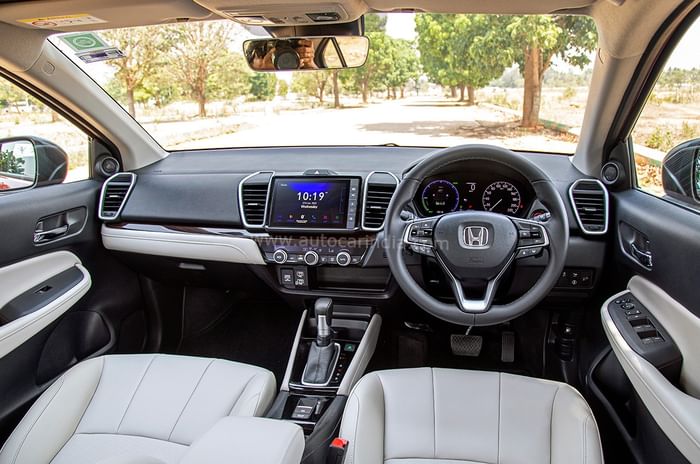
Otherwise, the City Hybrid’s interior is no different to those of other City models. It’s got the same neat dashboard, offers excellent frontal visibility and scores superbly on seat comfort. The throne-like front seats and sofa-like rear seats really are among the highlights of the package. It’s a roomy cabin, too, with lots of legroom at the back and enough width to accommodate three adults in reasonable comfort. The upward sloping floor that’s designed to serve as a footrest has become a City trademark but works best for average-sized adults; taller occupants will find that it compromises the seating position. The latter lot will also find the centre armrest positioned too low for comfort.
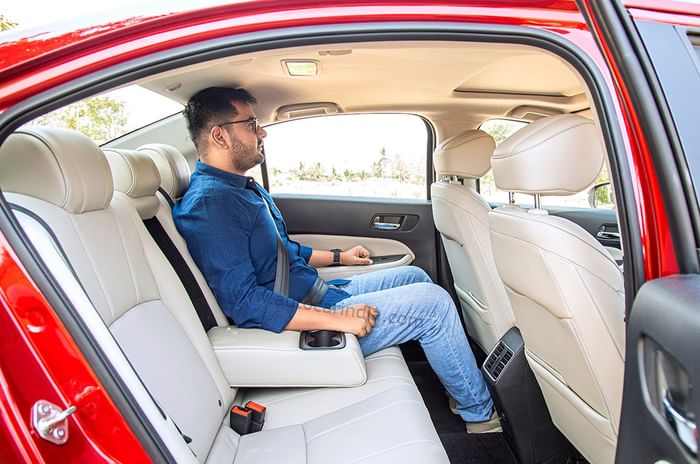
Like the standard City, the Hybrid scores well on in-cabin storage, with lots of place for small items, bottle holders on each of the doors and even nifty mobile phone pockets at the back. However, the Hybrid does compromise big time in terms of luggage space. Boot capacity is down from 506 litres to 306 litres. Honda has had to raise the boot floor to accommodate both, the lithium-ion battery that’s positioned just aft the rear seat and a space saver spare tyre, and this means you’ll be able to fit two large suite cases at a squeeze, but no more. A compartment under the boot floor can hold a soft bag or two. The City Hybrid’s limited luggage space could be a deal breaker for many.

Honda City Hybrid: features and safety
The City Hybrid is only offered in fully-loaded ZX form and thanks to inclusions like rear disc brakes, an electronic parking brake, ADAS features and more, it actually goes one-up on the standard model’s ZX trim. LED headlights, keyless entry and go, leather upholstery, a sunroof and connected tech are some of the key comfort features onboard. Just wish Honda had upgraded the 8.0-inch touchscreen as well. It’s hard to read on bright days, the interface looks dated, and it doesn’t support wireless Android Auto or Apple CarPlay. On the subject, a wireless phone charger is also a paid accessory.
The City Hybrid, an ASEAN NCAP 5-star rated car, promises plenty by way of safety – six airbags, ABS, ESC, traction control and ISOFIX child seat mounts are part of the package. The safety suite also includes a handy Lane Watch camera that relays a feed from the left wing mirror of blind spots onto the infotainment screen. And then there are the ADAS or advanced driver assistance systems. Interestingly, the City Hybrid’s ADAS system works on data gathered by a windscreen camera alone and doesn’t feature radar or LiDar tech. Honda says the system has been calibrated for Indian conditions.
In practice, the City Hybrid’s ADAS features do what they’re supposed to well enough. Adaptive Cruise Control helps keep a safe distance to the vehicle ahead, though we did find the auto braking a bit jerky and not gradual enough. Road Departure Mitigation (it warns you and, if needed, steers the car into the lane) and Lane Keep Assist (it automatically keeps the car centred in a lane) worked well on the smooth and well-marked roads on our media drive, but the true test will be on highways with patchy markings, conditions that Honda says the system is well versed with. We didn’t dare try the Collision Mitigation Braking System that automatically applies the brakes in the event of an impending collision, but in our distracted times, it’s nice to know that there’s an added safety net. Auto high beam that regulates the headlights based on traffic in the vicinity of the vehicle is another feature of great interest but one we couldn’t try.
Honda City Hybrid: powertrain
The Honda City Hybrid’s powertrain is a complex piece of kit, so we’ll try to break it down part by part. As with any strong hybrid arrangement, there’s an engine, electric motors and a lithium-ion battery pack.
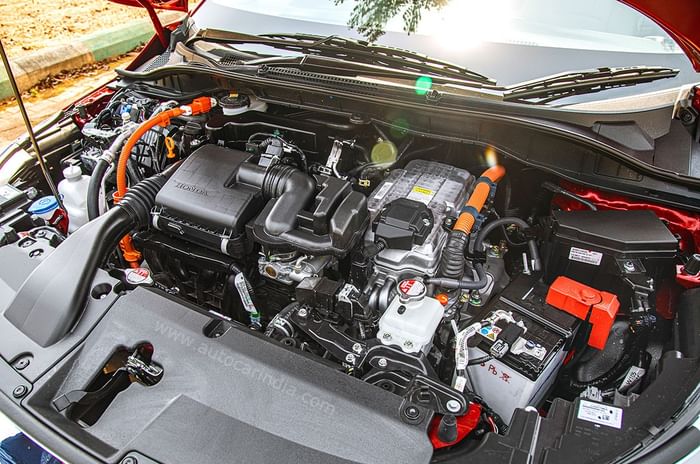
Like the standard City petrol, the City Hybrid gets a 1,498cc, four-cylinder petrol engine. However, the City Hybrid’s unit runs the more efficient but less powerful Atkinson cycle, which explains why it makes a lower 98hp and 127Nm (versus 121hp and 145Nm). Complementing the engine are a pair of electric motors, the first of which is a 95hp electric generation motor. Driven by the engine, this motor is there to charge the lithium-ion battery pack located at the back. The second motor is a 109hp and 253Nm traction motor that draws power from the battery and the generator motor to actually drive the front wheels. It’s important to note that the engine and traction motor can independently and jointly drive the front wheels, as the conditions demand.
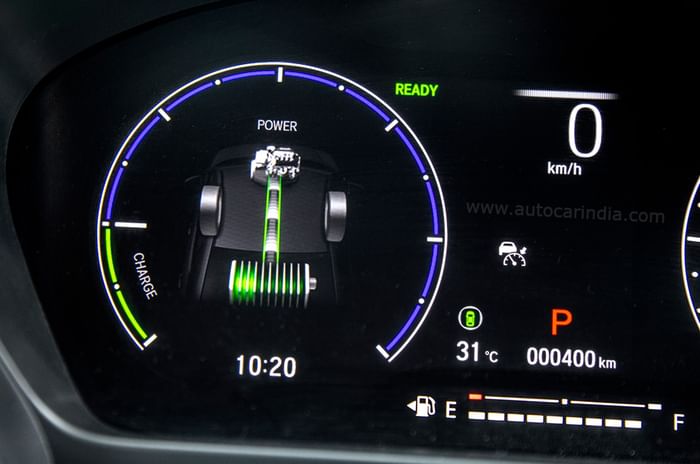
The system automatically shuffles between full-EV mode (engine off, traction motor powers wheels), hybrid mode (engine runs generator motor, traction motor powers wheels) and engine mode (engine powers the wheels, traction motor assists if needed). Mode selection is automatic and dependent on a host of factors, including battery charge level, throttle position and road speed. A lock-up clutch is used when the engine has to provide direct drive to the front wheels. Interestingly, this transmission is via a single-speed ratio that corresponds to overdrive of a typical gearbox. The broad idea is to run the engine in its most efficient zone, which is why Engine mode usually activates when road speed is in the 80-120kph band.
Honda City Hybrid: performance
The City Hybrid’s electronics and self-charging mechanism ensure that the lithium-ion battery pack never depletes fully, and what that means is, in most situations, pressing the Start button has the car come to life in pure-EV mode. With no engine noise, the initial moments of ‘ignition’ are very different to the experience in a petrol or diesel City. Gentle inputs at the accelerator, say in a parking lot or in slow-moving traffic, keep the City Hybrid in EV mode, and you can actually cover some distance (Honda doesn’t reveal figures for EV mode alone) before the system switches to Hybrid mode, which has the engine kick in to work the generator motor to replenish the battery.

This Hybrid mode offers a very unique experience. With the engine now running but the traction motor still powering the front wheels, the experience could have been disorienting. The City Hybrid, however, gets around this concern by simulating (remember it’s a single-speed gearbox) the steps of a CVT, complete with change in engine RPM, and this has been done entirely to deliver a more connected driving experience. In effect, the feel from behind the wheel is more akin to piloting a petrol CVT, even if it’s the electric motor that’s driving the front wheels. Performance in Hybrid mode is brisk.
It’s only when you drive faster, upwards of 80kph or so, that the clutch locks up, directing engine power straight to the front wheels. It’s great and easy-going when you’re cruising but high-speed overtakes do remind you that there’s all but a 98hp engine at your disposal. At max attack or at speeds above 120kph, the electric motor also contributes with added power. Honda says the City Hybrid tops off at 176kph and will do the 0-100kph dash in 10sec flat.
What’s nice is that the transition from EV mode to Hybrid mode and even Hybrid mode to Engine mode is seamless. There are no jerks or movements and it’s quite amusing to see the powertrain juggle charge and power delivery on the energy flow meter.
Honda City Hybrid: braking, ride and handling
Like other strong hybrids, the City Hybrid uses regenerative brakes. However, unlike other strong hybrids, the City’s arrangement is feelsome. You don’t get that wooden, disconnected feel on the first few millimetres of brake pedal travel. Rather, it feels very natural and well calibrated. The friction brakes, as mentioned before, now comprise rear discs and provide good stopping power. Also nice is the regenerative braking. You can choose between three levels of intensity via the steering-mounted paddles, though it doesn’t quite offer single-pedal driving even at the strongest setting. Selecting ‘B’ or Braking mode via the gear lever maintains the desired level of regeneration and is advisable for use on a downhill stretch.
In the areas of ride and handling, the City Hybrid feels familiar. It soaks up low-speed bumps well and high-speed manners are impressive too, though there’s still quite a bit of road noise that seeps into the cabin. The City Hybrid doesn’t quite dart into corners, but it feels composed and likeable around the bends.
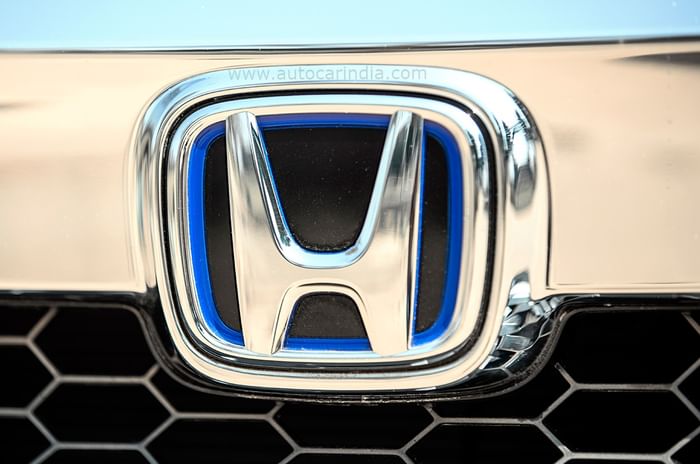
Honda City Hybrid: price and verdict
Strong hybrids have long been overlooked as a bridge between combustion engine cars and full battery electric vehicles. The Honda City Hybrid reminds us that there’s still a strong case for strong hybrids. It offers all the flexibility of a conventional petrol car with some of the key highlights of EVs, like far lower running costs. At a time when fuel prices are at record highs and the EV infrastructure is still only developing, the efficient City Hybrid should come across as a no-brainer.
Thing is, the City Hybrid's price of Rs 19.49 lakh (ex-showroom) throws the economics of going hybrid out of whack. You’d need a lot of running to benefit from its efficiency and make up for the added outlay over the standard petrol/diesel models that cost Rs 4 lakhs less.
That said, if the sticker price isn’t a bother, the City Hybrid is one of the smartest cars you could have for the money. It’s pleasant to drive, the fuel economy numbers are deeply satisfying and if you think about it, it’s quite a technical marvel too. Add in all that we like about the regular City and what you’re getting is a very accomplished package.







































